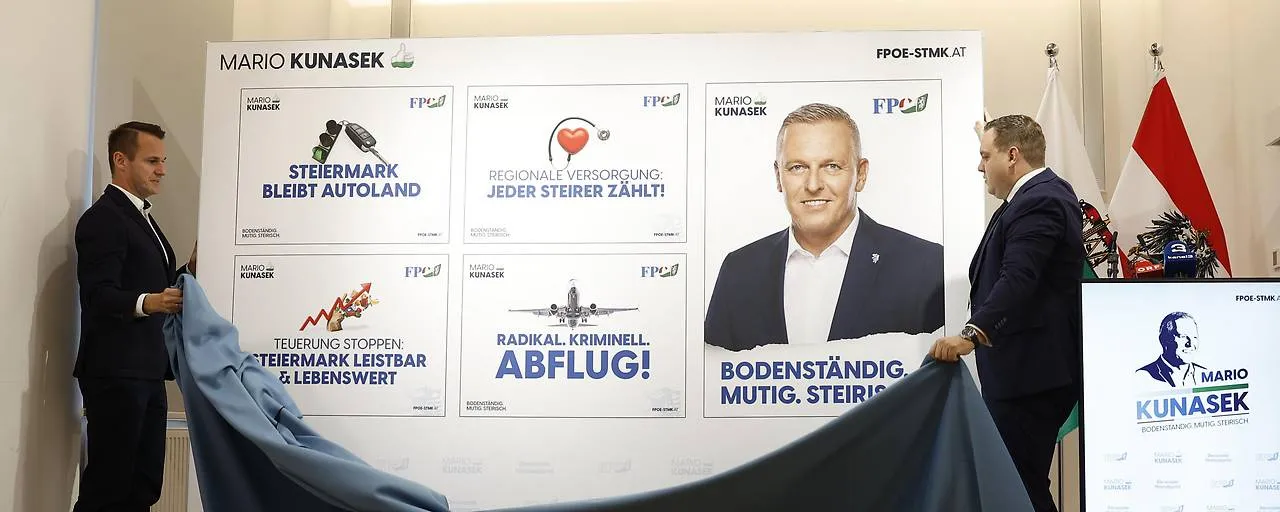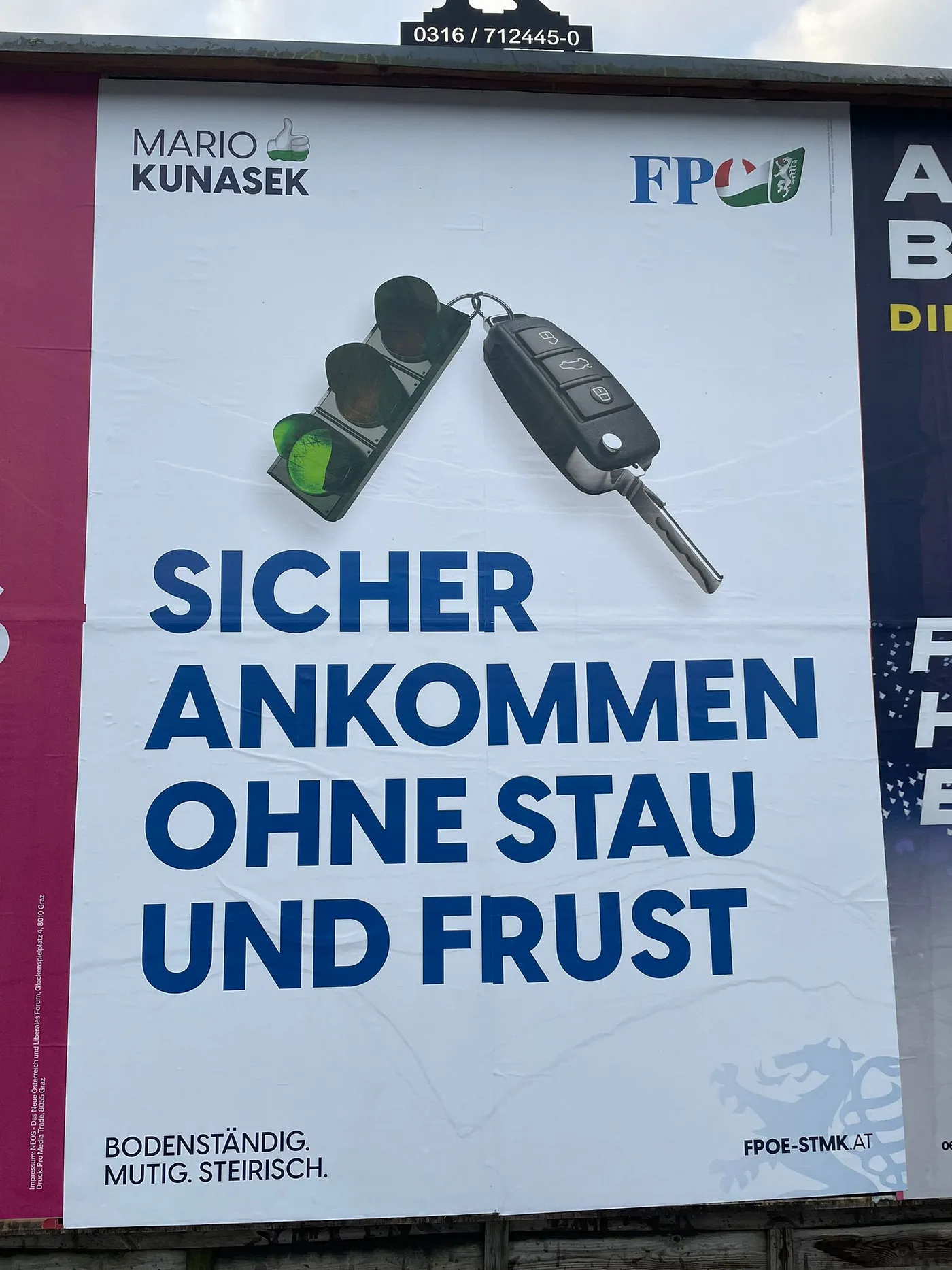Messaging for impact - what politics teaches us about audience targeting
A deep dive into transport policies that nobody asked for
In Austria, it sometimes feels like we’re perpetually in election mode. Party posters seem to be a permanent feature of our streets, from national campaigns to state-level contests. Just yesterday, the right-wing Freedom Party (FPÖ) narrowly won the national elections, and we’re already gearing up for state elections at the end of November.
Now, you may be wondering - what does this have to do with understanding your target audience?
A lesson in audience targeting
Recently, I came across something that made me think about brand messaging and audience segmentation. While driving through my small town in southern Styria, I noticed an FPÖ campaign poster that immediately caught my attention. It featured a green traffic light and car keys, with the text: “Steiermark bleibt Autoland” (Styria remains a car state).
 Source: https://steiermark.orf.at/stories/3276617/
Source: https://steiermark.orf.at/stories/3276617/
As a bike-loving millennial who uses a car only out of necessity, my first reaction was incredulity. In 2024, are we still prioritizing car ownership over sustainable alternatives? However, I moved on since I don’t have voting rights in Austria.
A few days later, while commuting to Graz, I saw another FPÖ poster with the same imagery but a different message: “Sicher ankommen ohne Stau und Frust” (Arrive safely without traffic and frustration).
 A picture of the FPÖ poster in Graz
A picture of the FPÖ poster in Graz
Why the difference in messaging? My immediate assumption was that the FPÖ was tailoring its campaign to appeal to different audiences. The message underscores local identity and pride in car culture in the car-dependent countryside. Meanwhile, the party focuses on safety and congestion concerns for Graz — a city with more sustainable transport options.
Analyzing the FPÖ’s targeted messaging
To fully understand the FPÖ’s strategy, let’s first explore some key aspects of Austria’s political and cultural context.
Austria’s political landscape
Austria’s political divide reflects its urban-rural split:
- National politics (as of November 2024): The FPÖ leads the opposition alongside the SPÖ (Social Democrats) and NEOS (centrists). The governing coalition includes the conservative ÖVP and the Green Party. While the FPÖ narrowly won the national elections, a new government has not yet been announced.
- Regional politics: Graz, a historically left-leaning city, has been led by the Communist Party (KPÖ) since 2021. In contrast, rural Styria leans conservative, with the ÖVP dominating these areas.
This divide extends to transportation preferences, where urban centers favor public transit and rural areas depend on cars.
Car ownership trends
Statistical data reinforces this divide:
- Styria (rural areas): With approximately 621 cars per 1,000 residents, rural Styria relies heavily on personal vehicles (Source: Statistik Austria).
- Graz (urban center): Although specific data isn’t available, urban areas like Vienna report significantly lower car ownership (366 cars per 1,000 residents) (Source: Statistik Austria). Graz’s compact layout and public transport options likely lead to similar trends.
These differences highlight the distinct priorities of rural and urban voters. Conservatives are generally less supportive of public transportation investments unless political trust is high. Progressives, on the other hand, favor public transit due to environmental concerns, social equity, and urban planning goals to reduce car dependency.
Decoding the FPÖ’s strategy
The FPÖ’s messaging is designed to resonate with these contrasting audiences:
Countryside poster: “Styria remains a car state” reinforces rural identity and pride in car culture.
- Emphasizes local identity and pride in car culture.
- Appeals to a rural audience where cars are essential for daily life.
City poster: “Arrive safely without traffic and frustration”
- Shifts focus to urban challenges like congestion and safety.
- Avoids overtly pro-car language, likely to avoid alienating city dwellers who prioritize public transport and cycling.
This nuanced approach shows how the FPÖ adapts its messaging to resonate with each target audience’s specific concerns and values.
Has a similar strategy worked before?
Tailored messaging between urban and rural audiences is not a new tactic. Two striking examples come to mind:
Donald Trump’s 2016 U.S. Presidential Campaign
- Key takeaway: Trump’s campaign appealed to rural voters by emphasizing economic revitalization in traditional industries and cultural values.
- Comparison to FPÖ: Like the FPÖ’s car-friendly messaging in rural Styria, Trump’s rhetoric was tailored to resonate with rural America’s identity and practical concerns. Urban areas saw a more tempered message focusing on economic policies, although cultural divides remained a key theme.
- Outcome: While this strategy secured Trump’s presidency, it deepened urban-rural polarization, which could offer lessons for how divisive or targeted messaging might backfire long-term.
Brexit Campaign in the UK
- Key takeaway: The “Leave” campaign used region-specific messaging, focusing on sovereignty and independence in rural areas while addressing economic concerns in cities.
- Comparison to FPÖ: Rural messaging emphasized pride and resistance to external control, much like the FPÖ’s “Styria remains a car state” slogan. Urban messaging, by contrast, avoided overt nationalism, focusing instead on bureaucratic inefficiencies and financial arguments.
- Outcome: The successful referendum highlighted how well-tailored, region-specific messaging can mobilize voters, though it also demonstrated the long-term consequences of catering to deeply divided groups.
What does the FPÖ stand for on traffic policy?
A quick look at the FPÖ’s official website highlights that the FPÖ’s stance is clearly pro-car. It strongly emphasizes the importance of preserving car usage and infrastructure while criticizing measures perceived as restrictive or unfavorable to drivers.
1. Criticism of anti-car measures: The policy condemns “anti-car ideology,” citing issues like reduced parking spaces, excessive speed limits, car-free days, and city tolls. These points demonstrate a strong opposition to policies aimed at limiting car use. Source: FPÖ Styria — Traffic Policy
2. Advocacy for car-friendly solutions:
- The demand to stop the elimination of parking spaces and maintain them in urban areas reflects a focus on accommodating car users.
- Emphasis on building a well-developed road network suggests prioritizing car infrastructure. Source: FPÖ Styria Campaign
3. Balanced but pro-car stance: While the policy acknowledges the importance of other modes of transport (public transportation, cycling), car users must not be marginalized or excluded. This framing highlights a pro-car bias, albeit presented under the guise of inclusivity. Source: FPÖ Styria Campaign
In summary, the policy advocates preserving and enhancing conditions for car users, positioning itself strongly against policies that might restrict car usage.
The neutrality of the Graz poster
The phrase “Arrive safely without traffic and frustration” is neutral on its own and does not explicitly signal being pro- or anti-car. However, the interpretation depends on the broader context:
- Pro-Car Context: If this phrase is part of a policy that emphasizes improving road infrastructure, reducing congestion for drivers, or opposing measures that limit car use, it aligns with a pro-car stance.
- Anti-Car or Balanced Context: If used in a policy that advocates for reducing car traffic through investments in public transport, cycling, or pedestrian infrastructure, it could align with an anti-car or balanced stance, as the aim might be to reduce traffic by discouraging car use.
Without additional context, the phrase focuses on improving the overall travel experience but could be framed in either direction. In Graz, the campaign’s neutral tone likely reflects an effort to appeal to urban voters without alienating their car-centric base.
Conclusion: Adapting to your audience matters
The FPÖ’s campaign underscores the importance of tailoring messages to different audiences. In rural Styria, car emphasis aligns with traditional values and practical needs. Graz’s shift to a more neutral tone reflects the city’s progressive transportation priorities.
Whether or not we agree with their policies, the FPÖ provides a compelling example of audience-driven communication. By understanding the unique concerns of their constituents, they’ve optimized their messaging to maximize impact. Though, as seen in other cases, the long-term consequences of such targeted strategies remain to be seen.
